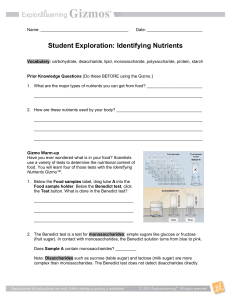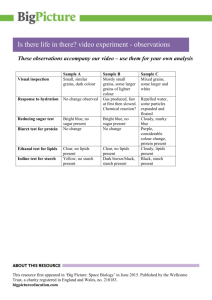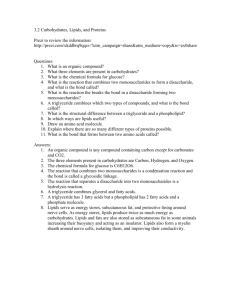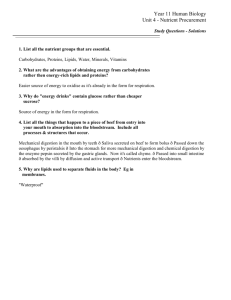Identifying Nutrients: Gizmo Activity Worksheet
advertisement
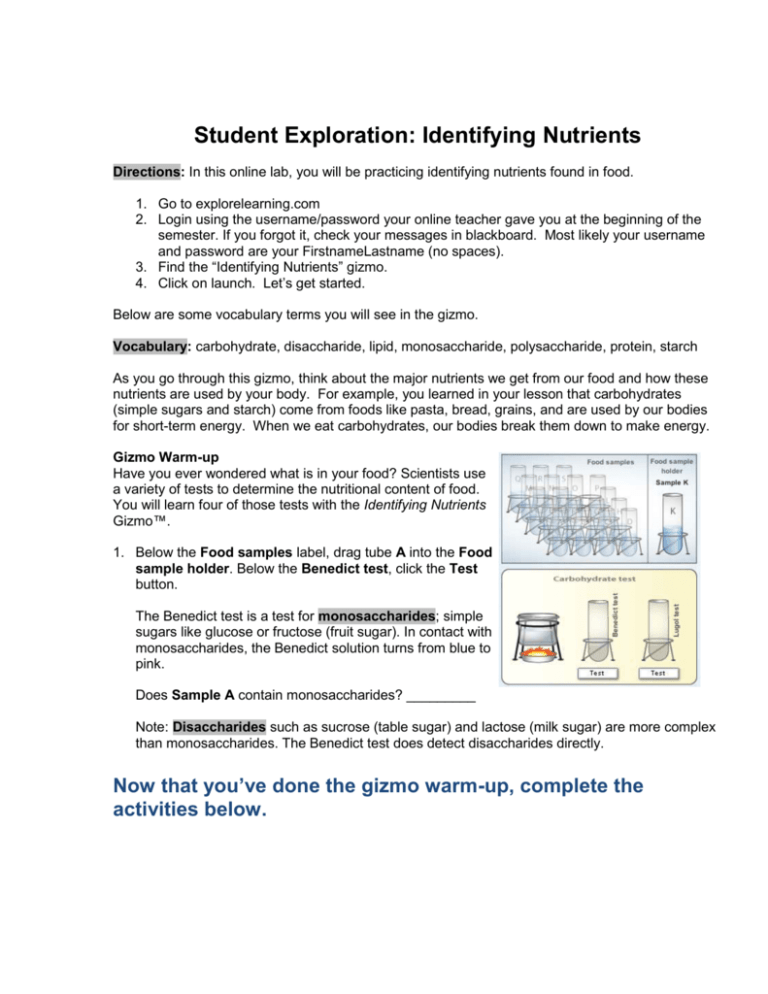
Student Exploration: Identifying Nutrients Directions: In this online lab, you will be practicing identifying nutrients found in food. 1. Go to explorelearning.com 2. Login using the username/password your online teacher gave you at the beginning of the semester. If you forgot it, check your messages in blackboard. Most likely your username and password are your FirstnameLastname (no spaces). 3. Find the “Identifying Nutrients” gizmo. 4. Click on launch. Let’s get started. Below are some vocabulary terms you will see in the gizmo. Vocabulary: carbohydrate, disaccharide, lipid, monosaccharide, polysaccharide, protein, starch As you go through this gizmo, think about the major nutrients we get from our food and how these nutrients are used by your body. For example, you learned in your lesson that carbohydrates (simple sugars and starch) come from foods like pasta, bread, grains, and are used by our bodies for short-term energy. When we eat carbohydrates, our bodies break them down to make energy. Gizmo Warm-up Have you ever wondered what is in your food? Scientists use a variety of tests to determine the nutritional content of food. You will learn four of those tests with the Identifying Nutrients Gizmo™. 1. Below the Food samples label, drag tube A into the Food sample holder. Below the Benedict test, click the Test button. The Benedict test is a test for monosaccharides; simple sugars like glucose or fructose (fruit sugar). In contact with monosaccharides, the Benedict solution turns from blue to pink. Does Sample A contain monosaccharides? _________ Note: Disaccharides such as sucrose (table sugar) and lactose (milk sugar) are more complex than monosaccharides. The Benedict test does detect disaccharides directly. Now that you’ve done the gizmo warm-up, complete the activities below. Activity A: Identifying nutrients Get the Gizmo ready: Click Reset. Drag Sample A into the Food sample holder. Introduction: Most food is composed of three types of molecules: carbohydrates, proteins, and lipids. Carbohydrates such as starches and sugars are major source of energy. Simple sugars are found in sweets and fruits. Starches are found in potatoes, cereal, pasta, flour, and other plant products. Proteins are used in body structures such as muscles, skin, and hair. Rich sources of proteins include meats, dairy products, and beans. Lipids (fats and oils) are used for energy, insulation, and as an essential building block of cells. Meats, dairy products, and oily plants such as olives are rich in lipids. Let’s find out how we test for carbohydrates, lipids, and proteins. You already tested sample A using the Benedicts test and found that sample A contained monosaccharides, because the solution changed from blue to pink. Remember that Benedicts tests for monosaccharides, so sample A contained monosaccharides (simple sugars). Now let’s test to see if sample A has starch (complex carbohydrate), lipids, and/or proteins. 1. Test: The Lugol test uses iodine to test for starch, a polysaccharide (complex sugar). Iodine turns dark purple in the presence of starch. Under Lugol test, click Test. Does sample A contain starch? _____ 2. Test: The Biuret test uses a solution of potassium hydroxide (KOH) and copper sulfate (CuSO 4) to test for protein. The Biuret solution turns purple when proteins are present. Under Biuret test, click Test. Does sample A contain proteins? _____ 3. Test: The Sudan Red test uses a fat-soluble dye, Sudan Red, to indicate the presence of lipids. When lipids are present, the dye will be absorbed into the lipids, and will appear as concentrated spots of color in the test tube. (No spots indicates that lipids are not present.) Under Sudan Red test, click Test. Does sample A contain lipids? _____ 4. Summarize: Looking above at your tests, you should have found that sample A tested positive for monosaccharides only. Therefore, sample A contains monosaccharides, simple sugars. 5. Analyze: What kind of food is sample A most likely to be? A. Apple juice B. Baked beans C. Oatmeal D. Scrambled eggs If you put A) apple juice you would be correct! Apple juice contains simple sugars (monosaccharides). If sample A were baked beans, it would have tested positive for protein, because baked beans contain protein. If sample A were oatmeal it would have tested positive for starch, because oatmeal contains starch. And if it were scrambled eggs it would have tested positive for protein as well. Activity B: Get the Gizmo ready: Nutrients and food types Click Reset. Question: What nutrients does each food sample contain? 1. Collect data: Use the four available tests to find the nutritional content of samples E, G, and M. (Sample A has been done for you as an example.) Record results on the table below. – Monosaccharides Test results – are these nutrients present? Yes Lipids – Sudan Red test Biuret test Lugol test – Lipids Test Proteins + Protein Test Starches A Benedict test Food sample Carbohydrate Tests No No No E G M 2. Analyze: Look at the results for samples A, E, G, and M. Try to think of a food that each sample might be. Gizmo Check For Understanding - Identifying Nutrients Multiple Response Identify one or more choices that best complete the statement or answer the question. ____ 1. If I were testing a potato chip to see what nutrients potato chips had, which tests do you think would show a positive result? a. Benedicts c. Iodine b. Biurets d. Sudan Red Matching How do we test for carbohydrates, proteins, and lipids? Match the test with what nutrient it tests for. a. Benedicts c. Iodine b. Biurets d. Sudan Red ____ 2. Used to test for complex carbohydrates (starch). ____ 3. Used to test for simplecarbohydrates (monosaccharides). ____ 4. Used to test for lipids. ____ 5. Used to test for proteins. Short Answer 6. If I wanted to see whether or not an unknown sample of food contained protein, what test would I use and what would I look for as an indication that it tested positive for protein? 7. Take a look at your results from Activity B. Give an example of a type of food that sample E might contain. 8. Do you think sample M would most likely be butter, chicken, or rice? 9. Sample G is most likely table sugar. Why do you think sample G did not test positive when using Biuret’s solution? 10. Why is it important to understand the nutritional content of food?


